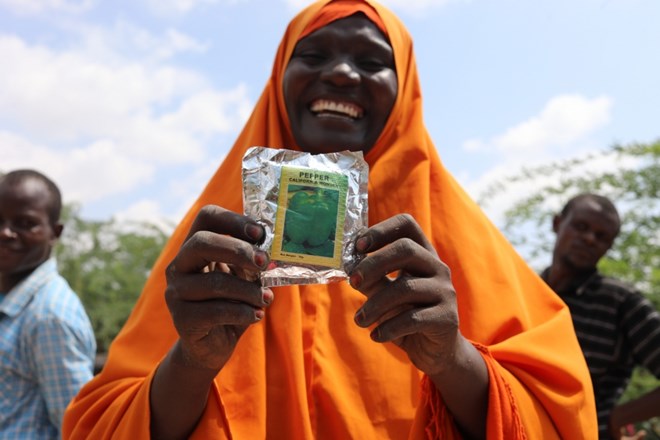
Saturday January 16, 2021

In December 2019, Cyclone Pawan hit Ali Mahamud Rubaax’s village of Dharkeynley in Beletweyne, central Somalia.
The storm’s rain caused the river levels to reach their maximum, breaking their banks and overflowing into the village and surrounding areas leaving most of the town under water. About 182 000 people from this district were displaced. Some drowned. Others had gone missing.
This wasn’t the first time Ali dealt with flooding. As a lifelong farmer, he had often seen the river overflow and destroy his crops.
“When the flooding ended last year, we started planting seeds, but then the water came back again,” Ali explains. It is part of the lot of farmers in this low-lying but economically important hub of Beletweyne, which provides services to surrounding rural communities.
But Pawan was so intense that, in just a few days, parts of Somalia received as much rain as they normally would over an entire year. The scale of flooding it caused was worse than the typical inundations endured by farmers like Ali. And this time, with the rain, came the locusts.
Rain and winds are two crucial elements that cause desert locusts to multiply and spread rapidly. Cyclone Pawan made the weather conditions that much more conducive to their multiplication, sparking the largest desert locust infestation to affect Somalia in generations.
Considered the most destructive migratory pest in the world, the desert locust is highly mobile and can travel with the wind up to 150 km/day.
“First the water damaged my farm, then the desert locusts came and ate everything,” Ali describes. “Because of the locusts, we lost everything on our farm. It became a failed season.”
Gearing up for the long haul
In November 2020, nearly a year after Pawan abetted the first locust invasion, another such storm — the strongest to hit Somalia in recorded history, Cyclone Gati — dumped around two years-worth of rain on the country over the span of just a few days. Even after the unprecedentedly large locust control efforts of the preceding months, these rains provoked yet another round of breeding of the voracious insect in Somalia, as well as in nearby Ethiopia.
“With the recent invasion of a new generation of desert locusts, large areas of cropland and pasture are at risk of being damaged,” says Ezana Kassa, FAO Emergency Coordinator in Somalia. “The impact can have severe consequences for agricultural, agropastoral and pastoral livelihoods in a context where food security is already fragile.”
Ali and about 2 500 other households in Beletweyne district received cash support from FAO to help them survive the desert locust invasion. Farming families also got seeds and tools to sustain their farming in the long-term.
“The seeds arrived when we needed them the most. I do not have money to buy seeds, but at least I can plant them now,” says Iraado.
“The help that FAO gave us is very important because our lives depend on the land,” Ali says. “I hope in the future that these seeds that I am planting will change my life and the lives of my family members.”
In addition to helping farmers like Ali, FAO, with the generous support of its donors, is supporting governments in scaling up their locust containment operations to meet the renewed threat.
In Somalia, the locust response is taking place alongside ongoing FAO efforts to help farmers diversify their crops and become more resilient to shocks like flooding or drought. This includes restoring river embankments to contain flooding and providing veterinary care to keep the livestock that millions of Somali pastoralists depend on healthy and strong.